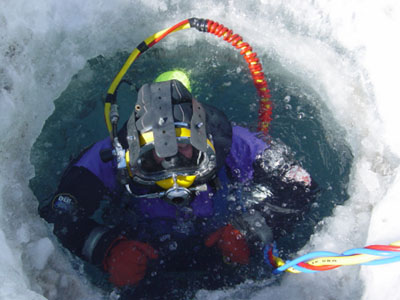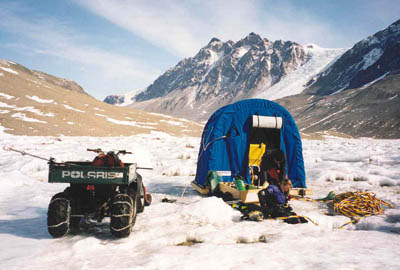|
Day
#1
One successful dive.
One dive stopped because
water froze in the purge valve of a face mask, causing a free
flow of air into the mask that would have depleted the compressed
air tank at the surface.

Maria
enters the dive hole
Click on
the picture to see a larger view |
|
Day #2
One successful dive.
One dive that was successful except for a diver losing a fin and
boot that later had to be retrieved.
|
Day #3
Two successful dives.
One diver fell on lake ice, hurt back, and couldn't dive for several
days.
|
Days #4-6
Two successful dives each day.
|
|
Day #7
In the middle of a dive, Ian, who is diving, talks with Donna
and Maria who are at the surface and tells them, "I think
I'm getting a little low on oxygen here." After some initial
moments of panic upon hearing the news, Maria and Donna go into
action and try to figure out what's wrong and how to deal with
it. Thirty feet below the surface, Ian remains calm. Like any
good diver, he has a back up plan. In this case it's a small,
seven-pound pony tank that Ian has brought with him. All Ian
has to do is turn a knob on the tank and air will flow into
his face mask. He has 10 minutes to surface.
After he does so, Ian finds out
that part of his gear was getting water trapped inside of it.
The water was then freezing up and causing problems with air
flow. Later on that day, the air compressor breaks down. The
researchers make several attempts to fix it but to no avail.
Finally, they call a mechanic at McMurdo Station and ask for
help.
|
Day #8
A mechanic is helicoptered out to the Dry Valleys from McMurdo
Station to try and fix the compressor. He can't figure out what's
wrong.
|
|
Day
#9
With the air compressor out of commission, the team decides
to do a dive air supplied by scuba tanks worn like a backpack.
Unlike the air compressor dives in which team members have been
going down solo, dives with scuba tanks are done using a two-person
buddy system as a safety measure. Each buddy's scuba tank has
an extra regulator. If one buddy has a problem getting air,
he or she uses the extra regulator attached to the buddy's air
tank. Today Ian and Maria are buddies.
In addition to
the alternative gear and safety set up, today's dive is unusual
for another reason. Normally the divers descend to the lake
bottom at around 35 feet.
But on this dive Ian and Maria are going 100 feet below the
surface to the deepest part of Lake Hoare. There, they'll be
checking out life in the sulfide zone. The sulfide zone is anoxic,
containing no pure oxygen. Instead organisms in this zone, like
bacteria, reduce sulfate to sulfide to obtain oxygen. The layer
of free-floating bacteria make it seem as if the divers are
descending through mist or wispy clouds. But the sulfide the
organisms produce has an overwhelming rotten egg smell that
penetrates the rubber that the divers' suits are made of. Even
Donna, monitoring the dive's progress on top of the ice gets
a whiff via the communication tubes that link Ian and Maria
to the surface. So the divers spend five minutes in the zone,
grab their samples, and get out.
|
|
Days #10-12
A new air compressor arrives. Ian, Donna, and Maria average
two successful dives per day over the next three days.
 Dive hut where the air compressor
is located.
Dive hut where the air compressor
is located.
Click on
the picture to see a larger view
|
|
Days #13-16
One diver gets sick. Doctors want to medivac the diver out (evacuate
the person for medical reasons) but bad weather prevents the helicopters
from flying to the Dry Valleys from their home base at McMurdo
Station. No dives done. Safety requires three experienced divers
to be present at each dive.
|
Day #17
Weather at McMurdo Station improves. Diver evacuated, eventually
flown to Christchurch, New Zealand, and recovers. Back up diver
flown in.
|
Days #18-20
Dives resume.
|
Day #21
Time to pack up all the gear.
|
Day #22
Team members are helicoptered back to McMurdo Station where they
will catch a flight to Christchurch. |
Summary
34 successful dives in 22 days. Everyone safe and sound. |

